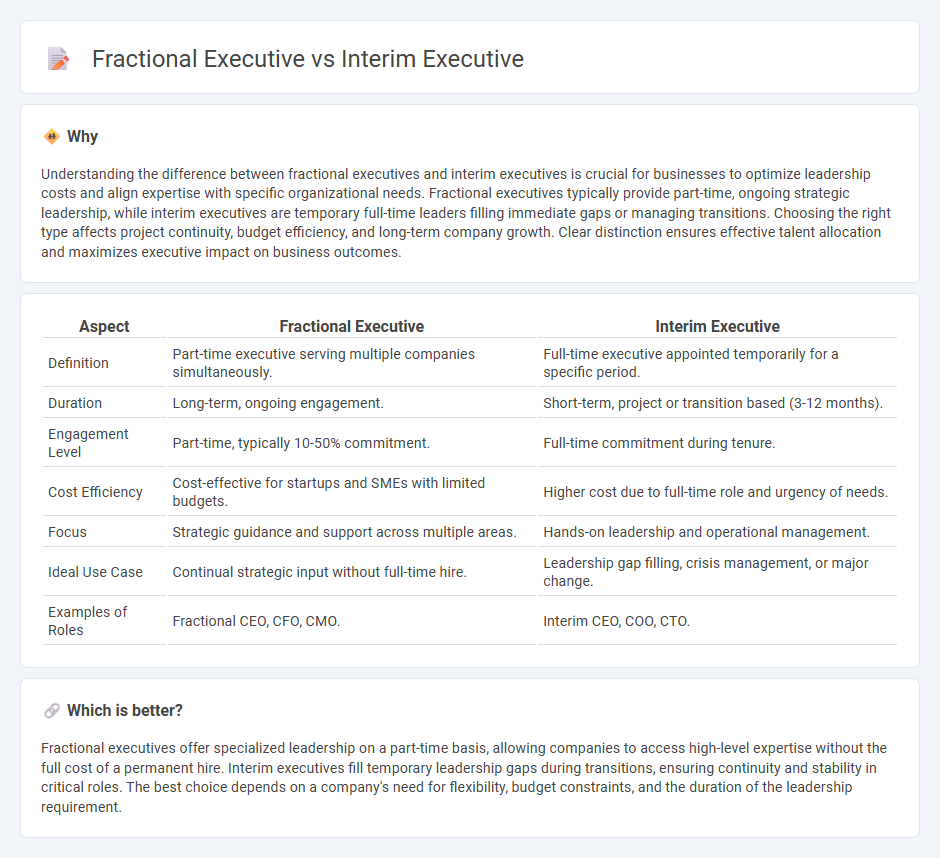
Fractional executives provide specialized leadership on a part-time basis, allowing companies to access high-level expertise without the commitment of a full-time hire. Interim executives fill temporary leadership gaps during transitions, bringing immediate experience to stabilize operations and drive strategic initiatives. Explore the key differences and benefits of fractional versus interim executives to find the best fit for your organization's needs.
Why it is important
Understanding the difference between fractional executives and interim executives is crucial for businesses to optimize leadership costs and align expertise with specific organizational needs. Fractional executives typically provide part-time, ongoing strategic leadership, while interim executives are temporary full-time leaders filling immediate gaps or managing transitions. Choosing the right type affects project continuity, budget efficiency, and long-term company growth. Clear distinction ensures effective talent allocation and maximizes executive impact on business outcomes.
Comparison Table
| Aspect | Fractional Executive | Interim Executive |
|---|---|---|
| Definition | Part-time executive serving multiple companies simultaneously. | Full-time executive appointed temporarily for a specific period. |
| Duration | Long-term, ongoing engagement. | Short-term, project or transition based (3-12 months). |
| Engagement Level | Part-time, typically 10-50% commitment. | Full-time commitment during tenure. |
| Cost Efficiency | Cost-effective for startups and SMEs with limited budgets. | Higher cost due to full-time role and urgency of needs. |
| Focus | Strategic guidance and support across multiple areas. | Hands-on leadership and operational management. |
| Ideal Use Case | Continual strategic input without full-time hire. | Leadership gap filling, crisis management, or major change. |
| Examples of Roles | Fractional CEO, CFO, CMO. | Interim CEO, COO, CTO. |
Which is better?
Fractional executives offer specialized leadership on a part-time basis, allowing companies to access high-level expertise without the full cost of a permanent hire. Interim executives fill temporary leadership gaps during transitions, ensuring continuity and stability in critical roles. The best choice depends on a company's need for flexibility, budget constraints, and the duration of the leadership requirement.
Connection
Fractional executives provide specialized leadership on a part-time or project basis, allowing organizations to access high-level expertise without a full-time commitment, while interim executives offer temporary management to fill sudden vacancies or lead transitions. Both serve as flexible employment solutions that address short-term leadership needs, helping companies maintain continuity and achieve strategic goals. Their shared focus on adaptable executive talent bridges gaps during organizational change or growth phases.
Key Terms
Duration of Engagement
Interim executives typically serve in a temporary capacity, often for 3 to 12 months, to address urgent leadership gaps or specific projects, whereas fractional executives engage part-time over longer periods, such as 6 to 18 months or more, providing ongoing strategic guidance without full-time commitment. The duration of engagement for interim executives is usually intensive and short-term, focusing on immediate business needs, while fractional executives offer sustained support that aligns with long-term organizational goals. Explore further to understand which executive model best fits your company's leadership requirements.
Scope of Responsibility
Interim executives typically assume full leadership roles with broad responsibilities during transition periods or crises, managing entire departments or organizations to maintain stability. Fractional executives provide part-time, specialized expertise, focusing on specific functions to support strategic initiatives without committing to full-time operational control. Explore the detailed differences to determine the best executive solution for your business needs.
Level of Integration
Interim executives offer temporary leadership, fully integrating into the organization's management team to address urgent needs during transitions or crises, typically for a defined period. Fractional executives provide part-time leadership, integrating at a strategic level with limited day-to-day involvement, allowing companies to access high-level expertise without full-time commitment. Explore how choosing between interim and fractional executives can align with your organization's integration needs.
Source and External Links
What are Interim Executives, and What Do They Offer? - Interim executives are highly experienced professionals who temporarily fill leadership gaps, manage transitions, and provide strategic guidance during times of organizational change or crisis, ensuring continuity and a smooth handover to permanent leaders.
Interim Executive Management: Seven Benefits to Consider - Interim executives offer an independent, objective assessment of an organization, support board and staff development, and help define leadership needs while managing transitions smoothly, especially when fresh perspectives and critical organizational changes are needed.
What is an Interim Executive? - Interim executives are change management experts with proven success across industries who take on short-term assignments to drive change, deliver results, and maintain calm leadership under pressure during critical periods.
 dowidth.com
dowidth.com